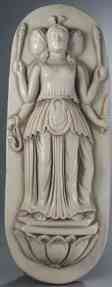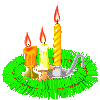

Imbolc, Oimelc, Imbolg, or Candlemass (the Christianized version of the name) is the celebration that occurs when the Sun reaches 15 ° Aquarius, and is therefore considered a Major Sabbat. This date was traditionally celebrated on Feb 1st or 2nd, and is still noted today in our country as "Ground Hog's Day", which marks that there is only 6 more weeks of winter; we have reached the half-way point.
There are some traditions that may say this holiday marks the beginning of Spring, but this doesn't hold up under scrutiny. Imbolc marks the middle of the winter season, just as Yule marked the beginning, and Ostara will mark the beginning of Spring at the Equinox.
The Celts marked this holiday as "Brigit's Day" or "Brid's Day" in Irish. Bridget is one of the few Pagan Dieties to have survived as Saints in the Christian religion. She was a very powerful and meaningful Goddess, and there was no way to force the populace to give her up, therefore they canonized her as "Saint Brigit" and up until 1220 BCE, her shrine at Kildare had a perpetual fire that was constantly tended by virgins, by the Priestesses of the Goddess, and after Christianity took over, it was continued by the virgin nuns. In the 1960's after Vatican II, it was decided that Saint Brigit did not have enough evidence to canonize her and then she was decanonized. However, in Ireland, she is still very much reverenced, as she is by Wiccans, as the triple Goddess. One aspect ruled poetry, writing, inspiration, and music; one ruled healing and midwifery and herbology, and one ruled fire, and the arts of smithcraft. Incidentally, this holiday was also called by the Christians, the Feast of the Purification of Mary, for it was believed that women were "unclean" for six weeks after giving birth. So since she had given birth at the Winter Solstice, this is the date when she would be purified. We look upon this as the time when the Goddess who gave birth at the Winter Solstice, is now transformed in the Maiden once again.
The Imbolc, or Oimelc, was the ancient Celtic festival celebrating the birth and freshening of sheep and goats, the Feast of Milk. Brigit's feast day was called "La Feill Bhride" and represents the seed that is waiting to stir again. It is a time of great anticipation and the celebration of possibilities. New life is about to awaken in the earth, the earth is furrowed and prepared to receive the seed.
The Valentine's Day festivities were also connected to this time, being celebrated now on Feb 14th. There are different explanations for this day, the Christian church having one, and folklorists having another. The Christian version states that a Dr. Valentine in ancient Greece used to perform illegal Christian weddings and he was sacrificed to the lions on this date and became Saint Valentine. Therefore, hearts and flowers are exchanged to honor the love that he had and the love of the Christian couples he joined in matrimony. The folklorists attribute this holiday to the "gallant" or "galantine" young men who pursued their sweethearts at this time, since some Latin languages pronounced "g" as a "v" in earlier times. Thus, the "valentine" would be the attentions of a would-be suitor, and whatever methods he might employ to win the maiden's heart!
At this time the Roman's celebrated Lupercalia, which also was a fertility festival. The Priests of Pan ran through the streets insuring women's fertility by spanking them with thongs made from goatskin and blessed by the local Strega. There are many cultures which had similar holiday practices at similar times. So much so that one has to wonder if this was due primarily to an agricultural society having a tendency to celebrate the same things at the same times of the year, or to an more universal religion or culture, having roots far in antiquity and being handed down over the centuries, changing only slightly over the generations?
Our tradition celebrates with a Brid's Bed, in which our Brid's Doll, made of corn, or straw, and dressed very prettily, is placed. She is the Maiden at this time, young, playful, and belonging only to herself, or virginal. Alongside her is placed an acorn wand, sized according to the Doll's size, which represents the penis, the regenerative male force in nature. We tell Brid our secret dreams and wishes that we want to see manifest. This is a time when we look to the future and dream! This is the Sabbat where we can plan ahead for what "seeds" we will "sow" in the coming year, and how we plan to nurture our seeds for a successful harvest later.
Other customs include lit candles in every window of the house, and keeping a perpetual candle on the Altar to Brid. Seeds are brought into circle to be blessed by the Goddess and the Gods and to absorb the circle's vibrant energy. Chant, dance, and sing, and send energy back into the earth to help her awaken, so that Spring may once more bloom. Straw can be woven into "Brid's Cross", "Bridget's Knot", or "Corn Maiden" and hung in the corners of rooms, over doorways, and over beds, for fertility, prosperity, and for the blessings of the Goddess. Remember - fertility doesn't necessarily mean having babies! Fertility of the mind, imagination, and of projects you are working to bring to "birth" are also desired manifestations, and will be blessed by fertility rituals. If you are of child-bearing ability and do not wish to be pregnant, than stress that the fertility you desire is of the mind, or of a certain project, or your creativity, etc, and that is what you will manifest.
It is also traditional in some covens for the Priestess to wear a crown of thirteen candles, a lunar number, representing herself as the Maiden of Light. Some covens have a crown made up, others use thirteen small electric bulbs instead of candles (which seems safer!). This is the Feast of Light, as the winter is dying away, and the sun grows stronger, and so bonfires are especially appropriate as well. In ages past, people jumped the bonefires to be cured of winter colds and flu. This is the holiday to bring your candles to circle, to have them be blessed by the Sabbat energies. We have small candles of each color in circle, and we mark them appropriately with symbols. Then during the year, when we dress any candle for any purpose, we add a few drops from our Imbolc candles, so that the Sabbat blessings and energy will also be added to the working.
The candles, the bonefires, and the lights are all symbolically adding energy to the waxing sun. In addition, they have another purpose. For remember at Samhain, Persephone went to the Underworld, to greet and care for the spirits of the dead? That was three months ago, and now, it is time for us to signal to her to return, and bring Spring back to the earth. We light the way for her to see her way back from Hades, and to remind her that we, with Demeter, are awaiting her here among the living.
In our tradition, this Sabbat is the only Sabbat where new coveners can be initiated into first degree. This makes this holiday a special one for us as it marks our "birthday" into the Craft! We always have a birthday cake for ourselves, and we celebrate together our inititation anniversary. We also use one candle for each covener, a large white candle, which is dressed, blessed, and lit only on Imbolc, and on each succeeding Imbolc thereafter until it is burned out. This candle is special to us, and among other things is a symbol of the Light which we are now celebrating, and which we embody.
The usual colors for Imbolc are white and yellow. White contains all the other colors in the spectrum, and therefore embodies all colors, and is a symbol of all possibilities; the beginning, the new. Yellow has always been the color associated with the Sun, along with gold, and is a call to the Sun to continue strengthening, and chase winter away. Traditional foods include potatoes, carrots, and any root vegetables, as people in ancient times were getting near the bottom of their root cellar by now. Also corn, as it is yellow for the Sun, and so many cultures relied on corn as a main staple of their diets. Lambs were being born around this time, and so lamb was also served at this holiday, along with rabbits, which were easy to trap, and other wild animals who stayed above ground during the cold months. We serve a hearty red wine during the God's half of the year, but you can also serve milk, since this was a celebration of the "freshening" of the goats as well. Indeed, it was often a "Milk Festival" and Oimelc means "milk of ewes".
Ideas for ritual can be the making of Brid's Beds, Brigit's Knots, Corn Dollies, as well as blessing seeds for your garden, blessing the water for the seeds, and blessing your candles for the coming year, to name just a few. In our tradition, we don't do personal magick on the Sabbats. We save that for the remaining 357 days of the year! Sabbats are for returning energy to the Gods and Goddesses, for being thankful for our blessings, and for blessing our dreams, wishes, and hopes. We make plans for the development of our lives on a spiritual level; for example: a happy home, healthy environment, peaceful country, and the renewal of the earth would be appropriate blessings for the Sabbat, and wonderful ideals to give your energy towards.
For more ideas and instructions on making some projects for Imbolc, or any other holiday, I strongly recommend Dan and Pauline Campanelli's books "Ancient Ways" and "Wheel of the Year", and also Scott Cunningham's "Spell Crafts". These books give you how-to illustrated instructions on a variety of holiday themes, and the Campanelli books also give you the historical background and how these projects tie in with each season.
Bibliography
"Candlemas: the Light Returns" by Mike Nichols
"Brigit of the Celts" by Moning Glory Zell